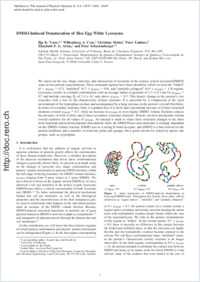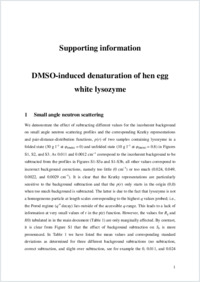DMSO-induced denaturation of hen egg white lysozyme
- Voets, Ilja K. Adolphe Merkle Institute, University of Fribourg, Switzerland
- Cruz, Willemberg A. Departamento de Qumica Fundamental, Instituto de Qumica, Universidade de So Paulo, Brazil
- Moitzi, Christian Adolphe Merkle Institute, University of Fribourg, Switzerland
- Lindner, Peter Institut Max von Laue-Paul Langevin, Grenoble, France
- Arêas, Elizabeth P. G. Departamento de Qumica Fundamental, Instituto de Qumica, Universidade de So Paulo, Brazil
- Schurtenberger, Peter Adolphe Merkle Institute, University of Fribourg, Switzerland - Division of Physical Chemistry, Center for Chemistry and Chemical Engineering, Lund University, Sweden.
-
23.08.2010
Published in:
- The Journal of Physical Chemistry B. - 2010, vol. 114, p. 11875–11883
English
We report on the size, shape, structure, and interactions of lysozyme in the ternary system lysozyme/DMSO/water at low protein concentrations. Three structural regimes have been identified, which we term the “folded” (0 < φDMSO < 0.7), “unfolded” (0.7 ≤ φDMSO < 0.9), and “partially collapsed” (0.9 ≤ φDMSO < 1.0) regime. Lysozyme resides in a folded conformation with an average radius of gyration of 1.3 ± 0.1 nm for φDMSO < 0.7 and unfolds (average Rg of 2.4 ± 0.1 nm) above φDMSO > 0.7. This drastic change in the protein’s size coincides with a loss of the characteristic tertiary structure. It is preceded by a compaction of the local environment of the tryptophan residues and accompanied by a large increase in the protein’s overall flexibility. In terms of secondary structure, there is a gradual loss of α-helix and concomitant increase of β-sheet structural elements toward φDMSO = 0.7, while an increase in φDMSO at even higher DMSO volume fractions reduces the presence of both α-helix and β-sheet secondary structural elements. Protein−protein interactions remain overall repulsive for all values of φDMSO. An attempt is made to relate these structural changes to the three most important physical mechanisms that underlie them: the DMSO/water microstructure is strongly dependent on the DMSO volume fraction, DMSO acts as a strong H-bond acceptor, and DMSO is a bad solvent for the protein backbone and a number of relatively polar side groups, but a good solvent for relatively apolar side groups, such as tryptophan.
- Faculty
- Faculté des sciences et de médecine
- Department
- AMI - Soft Nanoscience
- Language
-
- English
- Classification
- Chemistry
- License
-
License undefined
- Identifiers
-
- RERO DOC 20780
- DOI 10.1021/jp103515b
- Persistent URL
- https://folia.unifr.ch/unifr/documents/301800
Other files
Statistics
Document views: 111
File downloads:
- pdf: 356
- Supplementary material: 151

